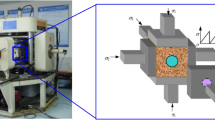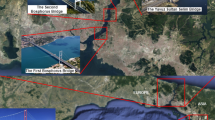Abstract
Semi-submersibles, best-suitable for oil and gas exploration in ultra-deep waters, possess attractive stability characteristics. While well-defined installation practices also bound them, failure of mooring lines shall pose challenges to their functional safety. Postulated failure analyses of a semi-submersible in 1500 m water depth in the Gulf of Mexico, installed with two other moorings namely: spread catenary and taut-moored, are discussed, and the fatigue damage is estimated using S–N curve approach. Results showed that while the motion responses of the semi-submersible with the proposed spread mooring are within the permissible limits, the fatigue life of the remaining mooring under the postulated failure condition is significantly decreased. Results show that the motion responses of semi-submersible with the proposed spread mooring are found to be within the permissible limits, except for a marginal increase under the mooring failure case. Tension in the remaining mooring lines is found to be dependent on the position of the failed mooring lines.















Similar content being viewed by others
References
Al-Solihat MK, Nahon M (2016) Stiffness of slack and taut moorings. J Ship Offshore Struct 11(8):890–904. https://doi.org/10.1080/17445302.2015.1089052
API 2INT-MET (2002) Interim guidance on Hurrican conditions in the Gulf of Mexico. American Petroleum Institute, API Bulletin1INT-MET, Washington DC
Chen P, Chai S Ma J (2011) Performance evaluations of taut-wire mooring systems for the deep-water semi-submersible platform. In: Proceedings of 30th international conference on ocean, offshore and arctic engineering, pp 207–215. https://doi.org/10.1115/OMAE2011-49281
DNVGL-RP-C203 (2005) Fatigue design of offshore steel structres. Det Norske Veritas, Norway
Garza-Rios LO, Bernitsas MM, Nishimoto K, Matsuura J (2000) Dynamics of spread mooring systems with hybrid mooring lines. J Offshore Mech Arct Eng 122(4):274–281. https://doi.org/10.1115/1.1315591
Huang W, Liu HX, Shan GM, Hu C (2011) Fatigue analysis of the taut wire mooring system applied for deep waters. J China Ocean Eng 25(3):413–426. https://doi.org/10.1007/s13344-011-0034-5
Kurian VJ, Yassir MA, Harahap IS (2010) Nonlinear coupled dynamic response of a Semi-submersible platform. In: The 20th international offshore and polar engineering conference. International Society of Offshore and Polar engineers
Qiao D, Wu F, Ou J (2014) Coupled analysis of a semisubmersible platform with two types of mooring systems. In: Proceedings of 24th international ocean and polar engineering conference
Srinivasan N, Chakrabarti S, Radha R (2006) Response analysis of a truss-pontoon semisubmersible with heave-plates. J Offshore Mech Arct Eng 128(2):100–107. https://doi.org/10.1115/1.2185679
Webster WC (1995) Mooring induced damping. Ocean Eng 22(6):571–591. https://doi.org/10.1016/0029-8018(94)00027-5
Wu Y, Wang T, Eide Ø, Haverty K (2015) Governing factors and locations of fatigue damage on mooring lines of floating structures. Ocean Eng 96:109–124. https://doi.org/10.1016/j.oceaneng.2014.12.036
Xue X, Chen NZ, Wu Y, Xiong Y, Guo Y (2018) Mooring system fatigue analysis for a semi-submersible. Ocean Eng 156:550–563. https://doi.org/10.1016/j.oceaneng.2018.03.022
Yan J, Qiao D, Ou J (2018) Optimal design and hydrodynamic response analysis of deep-water mooring system with submerged buoys. J Ships Offshore Struct 13(5):476–487. https://doi.org/10.1080/17445302.2018.1426282
Yang Y, Chen JX, Huang S (2016) Mooring line damping due to low frequency superimposed with wave frequency random line top-end motion. Ocean Eng 112:243–252. https://doi.org/10.1016/j.oceaneng.2015.12.026
Yuan Z, Ji C, Chen M, Zhang Y (2011) Coupled analysis of floating structures with a new mooring system. In: Proceedings of 30th international conference on ocean, offshore and arctic engineering, pp 489–496. https://doi.org/10.1115/OMAE2011-49597
Zhai GJ, Tang DY, Xiong HF (2011) Numerical simulation of the dynamic behavior of the deep-water semi-submersible platform under wind and waves. In: Chen C, Huang Y, Li G (eds) Advanced materials research, vol 243. Trans Tech Publications, Stäfa, pp 4733–4740. https://doi.org/10.4028/www.scientific.net/AMR.243-249.4733
Author information
Authors and Affiliations
Corresponding author
Rights and permissions
About this article
Cite this article
Chandrasekaran, S., Uddin, S.A. Postulated failure analyses of a spread-moored semi-submersible. Innov. Infrastruct. Solut. 5, 36 (2020). https://doi.org/10.1007/s41062-020-0284-2
Received:
Accepted:
Published:
DOI: https://doi.org/10.1007/s41062-020-0284-2




